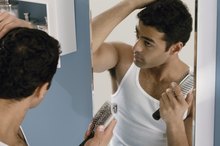What does fact checked mean?
At Healthfully, we strive to deliver objective content that is accurate and up-to-date. Our team periodically reviews articles in order to ensure content quality. The sources cited below consist of evidence from peer-reviewed journals, prominent medical organizations, academic associations, and government data.
The information contained on this site is for informational purposes only, and should not be used as a substitute for the advice of a professional health care provider. Please check with the appropriate physician regarding health questions and concerns. Although we strive to deliver accurate and up-to-date information, no guarantee to that effect is made.
Drugs to Prevent Hair Growth
Women experiencing excessive hair growth are commonly diagnosed with a condition called hirsutism. Symptoms of the condition include excessive, male-patterned hair growth on the face, chest, back and arms. While many temporary hair-removal options exist including tweezing, waxing, shaving and dissolving, such methods require constant upkeep. Permanent solutions include electrolysis and laser hair removal. These options require several sessions to complete and can be quite expensive. Medications and drugs to prevent future growth may also be used. However, medications do not reverse or remove existing hair.
Oral Contraceptives
Birth-control pills contain two key components that prevent hair growth: estrogen and progestin. These female hormones prevent hair growth by inhibiting the production of androgens, or male hormones, which are responsible for excessive hair growth, according to MayoClinic.com. Oral contraceptives are ideal for women who also desire birth control.
Anti-Androgens
How to Stop Hair From Growing on a Woman's Face
Learn More
Spironolactone, a common anti-androgen used to treat hair growth, prevents growth by blocking androgens. The drug prevents androgens from attaching to androgen receptors found within the body. It may take a month or more for anti-androgens to bring about favorable results.
Topical Creams
Eflornithine, a prescription cream used to prevent facial hair growth, is applied directly to the affected area. This medication gradually slows and halts hair growth. The benefits associated with this medication are not immediately noticeable. It may take up to two months for change to occur. Once treatment stops, hair growth returns to pre-treatment rates within two months, according to Drugs.com 2.
- Eflornithine, a prescription cream used to prevent facial hair growth, is applied directly to the affected area.
- Once treatment stops, hair growth returns to pre-treatment rates within two months, according to Drugs.com 2.
Related Articles
References
- MayoClinic.com: Hirsutism: Treatments and Drugs
- Drugs.com: Vaniqa
- "Milady's Standard Textbook of Cosmetology"; Milady, Diane Carol Bailey and Margrit Attenburg; 2008
- TeensHealth from Nemours. Hair removal. Updated August 2016.
- National Organization for Rare Disorders. Trichotillomania.
- NIH MedlinePlus. Depilatory poisoning. Updated April 9. 2020.
- Michigan Medicine. Electrolysis for removing hair. Updated October 30, 2019.
- American Academy of Dermatology. Laser hair removal: FAQs.
- USFDA. Vaniqa™. Updated July 27, 2000.
- Hamzavi I, Tan E, Shapiro J, Lui H. A randomized bilateral vehicle-controlled study of eflornithine cream combined with laser treatment versus laser treatment alone for facial hirsutism in women. J Am Acad Dermatol. 2007;57(1):54-9. doi:10.1016/j.jaad.2006.09.025
- Hamzavi, I., Tan, E., Shapiro, J., Lui, H. (2007). A randomized bilateral vehicle-controlled study of eflornithine cream combined with laser treatment versus laser treatment alone for facial hirsutism in women. J Am Acad Dermatol, Jul, 57, 1, 54-9.
- Wanitphakdeedecha, R., Alster, T.S. (2008). Physical means of treating unwanted hair. Dermatol Ther, Sep-Oct, 21, 5, 392-401.
Writer Bio
Kathy Mayse began her writing career as a reporter for "The Jackson-County Times Journal" in 2001. She was promoted to assistant editor shortly after. Since 2005, she has been busy as a successful freelancer specializing in Web content. Mayse is a licensed cosmetologist with more than 17 years of salon experience; most of her writing projects reflect this experience.









